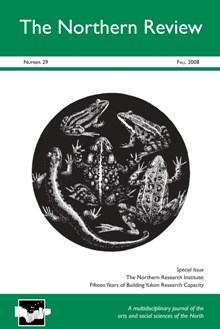The Role of Post-Glacial Lakes in the Pre-Contact Human History of Southwest Yukon Territory: A Late Drainage Hypothesis
Abstract
Archaeological site KaVn-2, located in the White River valley near Beaver Creek in the southwest Yukon, was first occupied between 10,130 and 10,670 BP, shortly after the area became deglaciated at around 11,000 BP. Despite the early occupation of KaVn-2 just after glacial retreat, and the presence of alpine sites as old as 8360 BP to the south, there are no known valley-bottom sites that have been dated to before 7200 BP. If deglaciation was complete in the area by 10,000 BP, as suggested by glaciologists, then why do we not have evidence for human occupation of the valleys until nearly 3,000 years later? The only known palaeogeographical phenomenon that could account for this void in the archaeological record is a large glacial lake—Glacial Lake Champagne—that occupied the major valleys of the southwest Yukon during deglaciation. Traditional interpretations suggest that this large lake drained between 9000 and 10,000 BP. Data summarized in this article support the hypothesis that Glacial Lake Champagne did not completely drain until well after 10,000 BP, and perhaps not until as late as 7200 BP. Other glacial lakes that formed in the study area within the past 2,000 years may have buried archaeological sites under thick deposits of silt and clay, and raised lake levels may have submerged archaeological sites around Kluane Lake under as much as thirty-five metres of water. Clearly, further research into the history of these lakes is critical to our understanding of the Holocene cultural and natural history of the southwest Yukon. This article describes dynamic hydrological processes that have occurred in the study area over the last 10,000 years and explain implications for the archaeological record.
Downloads
Published
Issue
Section
License
Authors who publish with this journal agree to the following terms:
a. Authors retain copyright and grant the journal right of first publication, with the work simultaneously licensed under a Creative Commons License that allows others to share the work with an acknowledgement of the work's authorship and initial publication in this journal.
b. Authors are able to enter into separate, additional contractual arrangements for the non-exclusive distribution of the journal's published version of the work (e.g., post it to an institutional repository or publish it in a book), with an acknowledgement of its initial publication in this journal.
c. The journal has the right to authorize third-party publishers & aggregators to include the Article in databases or other services (EBSCO, Proquest).
d. The journal has the right to share the Article on the Internet, through social media and other means.


